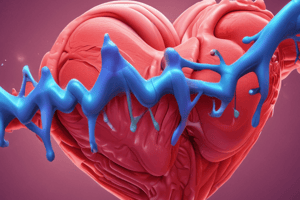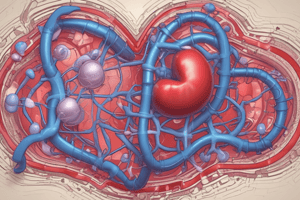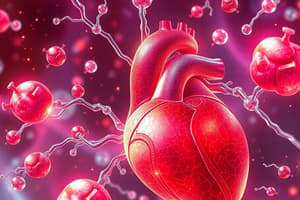Podcast
Questions and Answers
What is the rapid onset of action and absorption duration when taken orally?
What is the rapid onset of action and absorption duration when taken orally?
- 2 to 4 hours
- Over 5 hours
- 30 to 120 mins (correct)
- Less than 15 mins
Which condition is a contraindication for the use of Digoxin?
Which condition is a contraindication for the use of Digoxin?
- Sinus arrhythmia
- Ventricular tachycardia (correct)
- Chronic sinusitis
- Rheumatic fever
What adverse effect can patients experience due to cardiac glycosides?
What adverse effect can patients experience due to cardiac glycosides?
- Hyperactivity
- Increased appetite
- Heightened reflexes
- Vision changes (yellow halo) (correct)
In which group of patients should Digoxin be used cautiously due to potential adverse effects?
In which group of patients should Digoxin be used cautiously due to potential adverse effects?
What is the typical heart rate indicating tachycardia?
What is the typical heart rate indicating tachycardia?
Which of the following is an example of an irregular heart rhythm?
Which of the following is an example of an irregular heart rhythm?
What type of antiarrhythmics are Class I antiarrhythmics primarily considered?
What type of antiarrhythmics are Class I antiarrhythmics primarily considered?
What symptom might indicate a serious adverse effect of Digoxin?
What symptom might indicate a serious adverse effect of Digoxin?
What is the primary effect of cardiotonic agents on the heart muscle?
What is the primary effect of cardiotonic agents on the heart muscle?
Which condition is NOT a potential cause of heart failure?
Which condition is NOT a potential cause of heart failure?
What action does digoxin primarily have on heart rate?
What action does digoxin primarily have on heart rate?
How does heart failure affect the sarcomere unit of the cardiac muscle?
How does heart failure affect the sarcomere unit of the cardiac muscle?
Which of the following describes the therapeutic margin of digoxin?
Which of the following describes the therapeutic margin of digoxin?
Which of the following statements about cardiomyopathy is true?
Which of the following statements about cardiomyopathy is true?
What is a common consequence of valvular heart disease?
What is a common consequence of valvular heart disease?
Which of the following is an indication for the use of digoxin?
Which of the following is an indication for the use of digoxin?
What is a primary characteristic of Class IB antiarrhythmics?
What is a primary characteristic of Class IB antiarrhythmics?
Which of the following is a contraindication for Class IA antiarrhythmics?
Which of the following is a contraindication for Class IA antiarrhythmics?
What type of side effects can Class I antiarrhythmics cause?
What type of side effects can Class I antiarrhythmics cause?
Which Class II antiarrhythmic action results in an increased conduction time at the AV node?
Which Class II antiarrhythmic action results in an increased conduction time at the AV node?
Flecainide and Propafenone are best classified as which type of antiarrhythmics?
Flecainide and Propafenone are best classified as which type of antiarrhythmics?
Which of the following conditions should be approached with caution when using Class IB antiarrhythmics?
Which of the following conditions should be approached with caution when using Class IB antiarrhythmics?
Which of the following adverse effects is associated with Class I antiarrhythmics?
Which of the following adverse effects is associated with Class I antiarrhythmics?
Which of the following conditions is commonly treated with Class II antiarrhythmics?
Which of the following conditions is commonly treated with Class II antiarrhythmics?
What is a common adverse effect associated with Class II antiarrhythmics?
What is a common adverse effect associated with Class II antiarrhythmics?
Which of the following adverse effects is specifically associated with amiodarone?
Which of the following adverse effects is specifically associated with amiodarone?
Which statement accurately describes the mechanism of Class III antiarrhythmics?
Which statement accurately describes the mechanism of Class III antiarrhythmics?
In which situation are Class III antiarrhythmics generally considered to have no contraindications?
In which situation are Class III antiarrhythmics generally considered to have no contraindications?
What effect do Class IV antiarrhythmics have on calcium ions?
What effect do Class IV antiarrhythmics have on calcium ions?
What is the primary use of antianginal agents?
What is the primary use of antianginal agents?
Which of the following drugs has a rapid onset and short duration of action?
Which of the following drugs has a rapid onset and short duration of action?
What is a potential consequence of using Class III antiarrhythmics?
What is a potential consequence of using Class III antiarrhythmics?
What is the primary mechanism of action for Nitrates as antianginal agents?
What is the primary mechanism of action for Nitrates as antianginal agents?
Which side effect is commonly associated with Beta-Adrenergic Blockers?
Which side effect is commonly associated with Beta-Adrenergic Blockers?
What is the main indication for Statins as lipid-lowering agents?
What is the main indication for Statins as lipid-lowering agents?
What mechanism do Fibrates use to lower lipid levels?
What mechanism do Fibrates use to lower lipid levels?
Which side effect is associated with the use of Calcium Channel Blockers?
Which side effect is associated with the use of Calcium Channel Blockers?
Which of the following lipid-lowering agents is indicated for high triglycerides?
Which of the following lipid-lowering agents is indicated for high triglycerides?
What is a common side effect of Ranolazine?
What is a common side effect of Ranolazine?
What is the mechanism of action for Bile Acid Sequestrants?
What is the mechanism of action for Bile Acid Sequestrants?
What is the mechanism of action of cholesterol absorption inhibitors?
What is the mechanism of action of cholesterol absorption inhibitors?
Which of the following is a potential side effect of Niacin?
Which of the following is a potential side effect of Niacin?
In which scenario would PCSK9 inhibitors be indicated?
In which scenario would PCSK9 inhibitors be indicated?
What is the primary purpose of antiplatelet drugs?
What is the primary purpose of antiplatelet drugs?
What potential risk is associated with thrombolytic therapy?
What potential risk is associated with thrombolytic therapy?
What condition may be treated with anticoagulants?
What condition may be treated with anticoagulants?
Which of the following is NOT a monitoring consideration for lipid-lowering therapies?
Which of the following is NOT a monitoring consideration for lipid-lowering therapies?
What side effect is common with anticoagulants?
What side effect is common with anticoagulants?
Flashcards
Heart Failure
Heart Failure
A condition caused by dysfunction of the heart muscle, often due to damage or overwork.
Cardiomyopathy
Cardiomyopathy
A heart muscle disease that can lead to an enlarged heart and heart failure.
Cardiac Glycosides
Cardiac Glycosides
Drugs derived from plants that increase calcium in heart muscle to strengthen contractions.
Digoxin
Digoxin
Signup and view all the flashcards
Positive Inotropic Effect (dig)
Positive Inotropic Effect (dig)
Signup and view all the flashcards
Negative Chronotropic Effect (dig)
Negative Chronotropic Effect (dig)
Signup and view all the flashcards
Coronary Artery Disease
Coronary Artery Disease
Signup and view all the flashcards
Hypertension
Hypertension
Signup and view all the flashcards
Digoxin Action
Digoxin Action
Signup and view all the flashcards
Digoxin Renal Impairment
Digoxin Renal Impairment
Signup and view all the flashcards
Digoxin Contraindications
Digoxin Contraindications
Signup and view all the flashcards
Digoxin Adverse Effects
Digoxin Adverse Effects
Signup and view all the flashcards
Arrhythmia Definition
Arrhythmia Definition
Signup and view all the flashcards
Tachycardia
Tachycardia
Signup and view all the flashcards
Bradycardia
Bradycardia
Signup and view all the flashcards
Class I Antiarrhythmics
Class I Antiarrhythmics
Signup and view all the flashcards
Beta-blockers
Beta-blockers
Signup and view all the flashcards
Proarrhythmic Effects
Proarrhythmic Effects
Signup and view all the flashcards
Oral Administration
Oral Administration
Signup and view all the flashcards
IV Administration
IV Administration
Signup and view all the flashcards
What are Antianginal Agents?
What are Antianginal Agents?
Signup and view all the flashcards
How do Antianginal Agents work?
How do Antianginal Agents work?
Signup and view all the flashcards
What are common adverse effects of Class II Antiarrhythmics?
What are common adverse effects of Class II Antiarrhythmics?
Signup and view all the flashcards
Why are Class III Antiarrhythmics Proarrhythmic?
Why are Class III Antiarrhythmics Proarrhythmic?
Signup and view all the flashcards
What are the key adverse effects of Class III Antiarrhythmics?
What are the key adverse effects of Class III Antiarrhythmics?
Signup and view all the flashcards
Antianginal Agents
Antianginal Agents
Signup and view all the flashcards
Nitrates (Mechanism)
Nitrates (Mechanism)
Signup and view all the flashcards
Beta-Blockers (Mechanism)
Beta-Blockers (Mechanism)
Signup and view all the flashcards
Calcium Channel Blockers (Mechanism)
Calcium Channel Blockers (Mechanism)
Signup and view all the flashcards
Lipid-Lowering Agents
Lipid-Lowering Agents
Signup and view all the flashcards
Statins (Mechanism)
Statins (Mechanism)
Signup and view all the flashcards
Fibrates (Mechanism)
Fibrates (Mechanism)
Signup and view all the flashcards
Bile Acid Sequestrants (Mechanism)
Bile Acid Sequestrants (Mechanism)
Signup and view all the flashcards
Cholesterol Absorption Inhibitors
Cholesterol Absorption Inhibitors
Signup and view all the flashcards
PCSK9 Inhibitors
PCSK9 Inhibitors
Signup and view all the flashcards
Niacin (Nicotinic Acid)
Niacin (Nicotinic Acid)
Signup and view all the flashcards
Anticoagulants
Anticoagulants
Signup and view all the flashcards
Antiplatelets
Antiplatelets
Signup and view all the flashcards
Thrombolytics
Thrombolytics
Signup and view all the flashcards
INR (International Normalized Ratio)
INR (International Normalized Ratio)
Signup and view all the flashcards
Lifestyle Modifications for Lipid Management
Lifestyle Modifications for Lipid Management
Signup and view all the flashcards
Study Notes
Heart Failure
- Heart failure is a condition, once called "dropsy" or decompensation, involving dysfunction of the cardiac muscle.
- The sarcomere is the basic unit of the cardiac muscle.
- A sarcomere contains contractile proteins, actin and myosin, that interact but are kept apart at rest by troponin.
- Heart failure results from conditions damaging or overworking the heart muscle.
- Coronary artery disease is a cause of heart failure. It reduces blood flow, causing oxygen deficiency and impaired muscle function. Severe heart failure can result in a heart attack (MI), leading to heart muscle death and further impairing the heart's ability to pump blood.
Cardiomyopathy
- Cardiomyopathy is a heart muscle disease that can lead to an enlarged heart and eventual complete heart failure.
- Cardiomyopathy can be caused by viral infections, alcoholism, steroid abuse, or collagen disorders.
- It alters the heart muscle so that contraction and pumping are ineffective.
Hypertension
- Hypertension (high blood pressure) forces the heart to work harder, leading to enlarged heart muscle.
- Increased workload can cause heart failure.
Valvular Heart Disease
- Valvular heart disease leads to an overload of the ventricles.
- This occurs because the heart valves do not close tightly, allowing blood to leak backward into the ventricles.
Cardiotonic Agents
- Cardiotonic drugs increase calcium levels in heart muscle, boosting contraction strength and cardiac output, increasing urine production and decreasing blood volume, resulting in reduced heart workload.
- Cardiac glycosides were originally derived from the foxglove or digitalis plant. Digoxin (Lanoxin) is the most commonly used drug in modern times.
Actions and Indications of Digoxin
- Digoxin increases calcium in heart muscles, leading to stronger contractions (positive inotropic effect) and a slower heart rate (negative chronotropic effect).
- It reduces the heart's workload and increases urine output, lowering blood volume.
- It is used to treat heart failure, atrial flutter, atrial fibrillation, and paroxysmal atrial tachycardia.
- A narrow therapeutic margin exists, requiring careful monitoring between the therapeutic dose and toxic dose.
Pharmacokinetics of Digoxin
- Digoxin is available in oral and intravenous forms.
- Digoxin has rapid onset of action and absorption, typically within 30-120 minutes after oral dosing and 5-30 minutes after IV administration.
- Digoxin is distributed throughout the body.
- It is primarily excreted unchanged in the urine, so caution is required in patients with renal impairment, where the drug can accumulate and cause toxicity.
Contraindications and Cautions of Digoxin
- Digoxin use is contraindicated in patients with allergies to its components and with ventricular tachycardia or fibrillation, heart block, sick sinus syndrome, idiopathic hypertrophic subaortic stenosis (IHHS), acute MI, and renal/electrolyte abnormalities (high calcium, low potassium or magnesium).
- Use is also cautious in pregnant or lactating women due to potential effects on the fetus or neonate.
- Pediatric and geriatric patients are at higher risk for adverse effects and require close monitoring.
Adverse Effects of Digoxin
- Common adverse effects with Digoxin include headache, weakness, drowsiness, and vision changes (yellow halo around objects).
Antiarrhythmics
- Arrhythmias are abnormal heart rhythms where the electrical impulses coordinatating heartbeats don't work properly, and the heart beats too fast, too slowly, or irregularly.
Classification of Antiarrhythmics
- Class 1 Antiarrhythmics are sodium channel blockers.
- Class IB: Lidocaine is rapidly absorbed and has a short duration of action, used intravenously.
- Class IC: Flecainide and Propafenone are absorbed orally and have a longer duration of action.
- Class IA: Quinidine and Procainamide are absorbed orally with a long half-life.
Adverse Effects of Class 1 Antiarrhythmics
- CNS: dizziness, drowsiness, fatigue, twitching, numbness, slurred speech, vision changes, including convulsions.
- Gastrointestinal System: nausea, vomiting, changes in taste
- Other systems: Adverse effects with cardiac glycosides include headache, weakness, drowsiness, and vision changes (yellow halo around objects)
- Class I and other antiarrhythmics can induce adverse effects affecting the central nervous system (CNS), gastrointestinal (GI) system, cardiovascular system, and respiratory system.
Class II Antiarrhythmics
- Class II antiarrhythmics work by blocking beta-adrenergic receptors, inhibiting the effects of norepinephrine and epinephrine on the heart.
- This leads to decreased heart rate, reduced cardiac contractility, and prolonged atrioventricular (AV) node conduction time.
- Common uses include management of premature ventricular contractions, intraoperative/postoperative tachycardia, and as an antihypertensive.
Class III Antiarrhythmics
- Class III antiarrhythmics block potassium channels, slowing the outward movement of potassium during phase III of the action potential, prolonging it.
- Includes drugs like amiodarone, dofetilide, ibutilide, sotalol, and sotalol betapace AP.
Class IV Antiarrhythmics
- These drugs block the movement of calcium ions across the cell membrane, depressing the generation of action potentials and delaying repolarization.
- This slows automaticity and conduction.
- Includes diltiazem and verapamil.
Other Antiarrhythmics
- Drugs such as adenosine and Digoxin (discussed above).
Antianginal Agents
- Antianginal agents are used to relieve and prevent angina (chest pain).
- They work by either increasing the heart's oxygen supply or decreasing oxygen demand.
Types of Antianginal Agents
- Nitrates: Examples: Nitroglycerin, Isosorbide Mononitrate, Isosorbide Dinitrate, Mechanism: Dilate blood vessels, increasing blood flow to the heart.
- Beta-Adrenergic Blockers: Examples: Propranolol, Metoprolol, Atenolol, Mechanism: Reduce heart rate and contractility, decreasing oxygen demand
- Calcium Channel Blockers: Examples: Amlodipine, Diltiazem, Verapamil, Mechanism: Inhibit calcium entry into cells, relaxing blood vessels and reducing heart workload
- Ranolazine: Mechanism: Inhibits ion channels during cardiac repolarization, reducing oxygen demand, Uses: Chronic angina management.
Lipid-Lowering Agents
- Lipid-lowering agents are used to lower lipids (fats) in the blood, particularly cholesterol and triglycerides.
- They are crucial in managing and preventing cardiovascular diseases.
- These include statins (HMG-CoA Reductase Inhibitors), fibrates, bile acid sequestrants, cholesterol absorption inhibitors, and PCSK9 inhibitors.
- Common side effects include muscle pain, increased liver enzymes, and (rarely) increased diabetes risk.
Drugs Affecting Coagulation
- Anticoagulants: Prevent clot formation.
- Antiplatelets: Prevent platelets from clumping to form clots.
- Thrombolytics: Dissolve existing clots.
Anemia
- Anemia is a condition characterized by a deficiency in the number or quality of red blood cells or hemoglobin, a protein that carries oxygen.
- This reduced oxygen-carrying capacity in the blood leads to a variety of symptoms and complications.
- Conditions that can cause anemia can be treated with iron, vitamin B12, or folate supplements depending on underlying cause.
Medications for Hemolytic Anemias
- Used to treat anemias caused by the destruction of red blood cells.
- Examples include corticosteroids and immunosuppressants.
Medications for Thalassemia and Sickle Cell Anemia
- Medications help manage symptoms.
- Examples include hydroxyurea and luspatercept.
Medications for Anemia of Chronic Disease
- Medications aim to address the underlying inflammation or infection.
- Examples include erythropoiesis-stimulating agents and iron supplements.
Studying That Suits You
Use AI to generate personalized quizzes and flashcards to suit your learning preferences.




